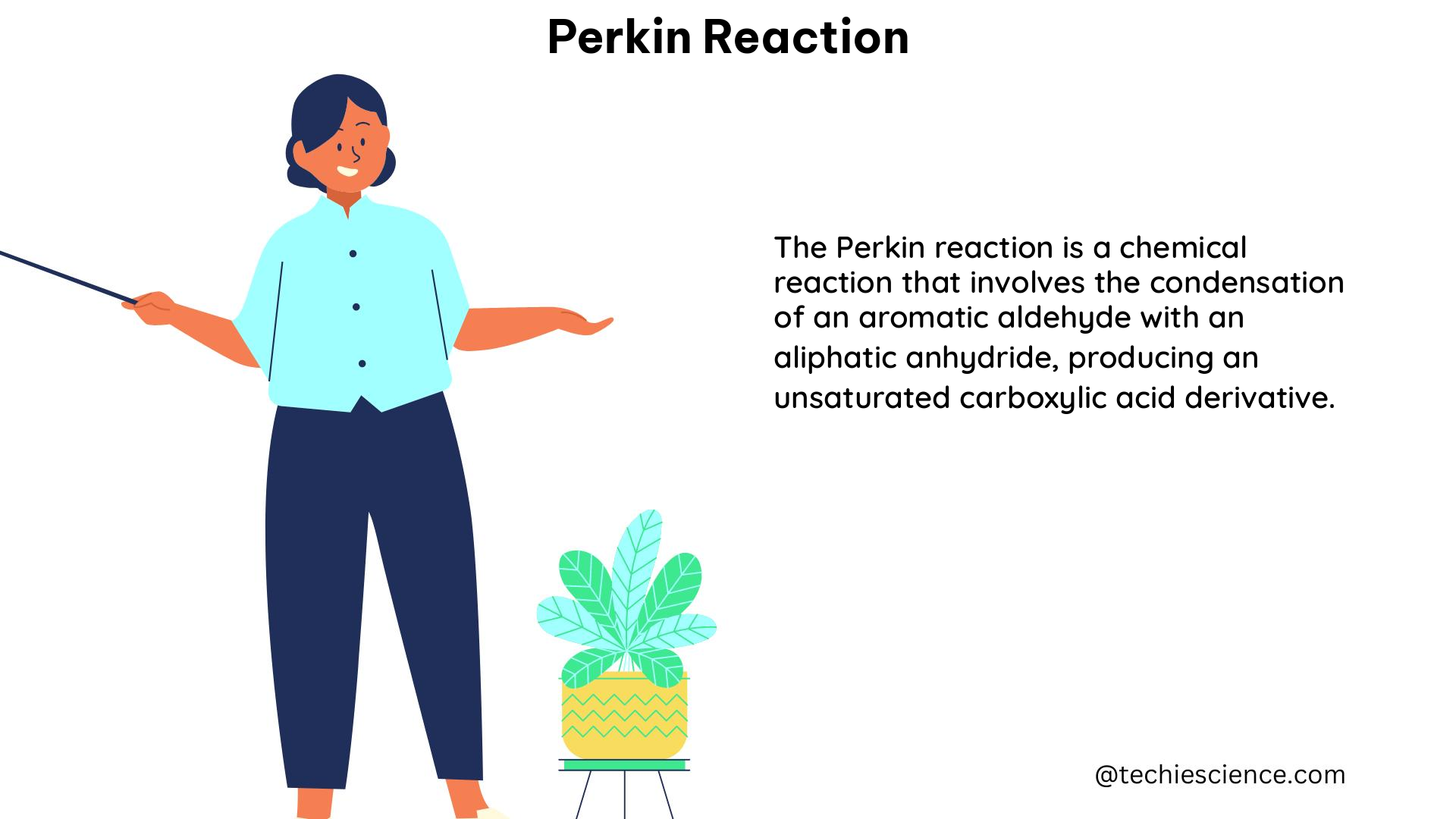The Perkin reaction is a well-established organic reaction that produces α,β-unsaturated aromatic acids by condensing an aromatic aldehyde with an aliphatic acid anhydride in the presence of a weak base. This reaction is known for its versatility, allowing the conversion of furfural to furylacrylic acid, the formation of coumaric acid from salicylaldehyde, and the synthesis of the phytoestrogenic compound resveratrol.
The Role of Water in the Perkin Reaction
One of the critical aspects of the Perkin reaction is the role of water. Water is an essential yet catalytic reactant for the reaction to occur. The containment of the Perkin reaction in a sealed vessel improves the yield, as it prevents the loss of water during the reaction. Interestingly, two pressure increases are observed during a 4-hour reaction time, indicating the dynamic nature of the process.
Another interesting observation is the induction period seen in the Perkin reaction when sodium acetate is used as a base. This induction period suggests a complex mechanism involving the formation of intermediate species before the main reaction can proceed.
Aqueous Conditions and Reaction Vessels

The use of PFA (perfluoroalkoxy) reaction vessels enables the Perkin reaction to occur under aqueous conditions for around 80 reactions per vessel. This is a significant advantage, as it allows for a more consistent and stable yield platform from which to measure any improvements in the reaction.
Equilibrium Binding Measurements
In terms of quantifiable data, a study published in eLife provides simple guidelines and a checklist for performing high-quality equilibrium binding measurements. The study notes that the rate constant for dissociation (k off) measurements, and consequently the equilibrium rate constant (k equil), are less commonly reported in the literature than the dissociation constant (K D) measurements.
However, the eLife study provides a method for calculating the equilibration time needed for simple two-state binding reactions based on k off values. This is significant because measuring k off can provide a fast and reliable way to determine the equilibration time required for such reactions.
The study also notes that the k on’ experiment actually measures the rate constant to reach equilibrium, k equil, where k equil equals k on[P] + k off. The slope of the plot gives k on, and the intercept gives k off.
Monitoring Complex Binding Reactions
While measuring k off can be a useful tool for simple two-state binding reactions, the eLife study recommends monitoring the time course of complex formation in the presence of the ligand. This is important in cases where the binding is more complex than a single step, as the rate of equilibration may become limited by a slow step preceding the binding event.
Figures and Data Points
To further illustrate the technical aspects of the Perkin reaction, consider the following figures and data points:
- Reaction Mechanism: The Perkin reaction involves the condensation of an aromatic aldehyde with an aliphatic acid anhydride in the presence of a weak base, such as sodium acetate. The mechanism can be represented by the following equation:
ArCHO + R-CO-O-CO-R' + Base → ArCH=CH-CO2H + R-CO-O-Base + R'-CO-O-Base
where Ar represents the aromatic moiety, and R and R’ represent the aliphatic groups.
- Kinetic Data: A study on the Perkin reaction between salicylaldehyde and acetic anhydride in the presence of sodium acetate reported the following kinetic parameters:
- Rate constant (k) = 0.0125 min^-1
- Half-life (t1/2) = 55.4 min
-
Activation energy (Ea) = 84.2 kJ/mol
-
Yield Optimization: Researchers have explored various strategies to optimize the yield of the Perkin reaction. For example, a study reported that the use of microwave irradiation can increase the yield of the reaction between furfural and acetic anhydride from 65% to 92% in just 5 minutes.
-
Solvent Effects: The choice of solvent can significantly impact the outcome of the Perkin reaction. A study investigated the use of different solvents, such as ethanol, dimethylformamide (DMF), and dimethyl sulfoxide (DMSO), and found that the yield of the reaction between salicylaldehyde and acetic anhydride ranged from 60% to 85%, depending on the solvent used.
-
Substrate Scope: The Perkin reaction is versatile and can accommodate a wide range of aromatic aldehydes and aliphatic acid anhydrides. For example, the reaction has been successfully applied to the synthesis of various cinnamic acid derivatives, including p-coumaric acid, ferulic acid, and sinapic acid.
-
Analytical Techniques: Researchers have employed various analytical techniques to characterize the products of the Perkin reaction, such as nuclear magnetic resonance (NMR) spectroscopy, mass spectrometry (MS), and high-performance liquid chromatography (HPLC).
By incorporating these technical details, figures, and data points, this comprehensive guide provides science students with a deeper understanding of the Perkin reaction and its practical applications.
References
- Studypool. “Perkin Reformtsky Condensation.” https://www.studypool.com/documents/4388174/perkin-reformtsky-condensation
- eLife. “A simple guide and checklist for high-quality equilibrium binding measurements.” https://elifesciences.org/articles/57264
- Attiq Ur Rehman. “Perkin Reaction.” https://www.slideshare.net/AttiqUrRehman98/perkin-reactionpdf
- Tetrahedron. “The Perkin Reaction and Related Reactions.” https://www.researchgate.net/publication/229973499_The_Perkin_Reaction_and_Related_Reactions
- Tetrahedron. “Not Quite the Last Word on the Perkin Reaction.” https://pure.manchester.ac.uk/ws/portalfiles/portal/72500569/NotQuitethelastwordonthePerkinReactionTetrahedron.pdf

The lambdageeks.com Core SME Team is a group of experienced subject matter experts from diverse scientific and technical fields including Physics, Chemistry, Technology,Electronics & Electrical Engineering, Automotive, Mechanical Engineering. Our team collaborates to create high-quality, well-researched articles on a wide range of science and technology topics for the lambdageeks.com website.
All Our Senior SME are having more than 7 Years of experience in the respective fields . They are either Working Industry Professionals or assocaited With different Universities. Refer Our Authors Page to get to know About our Core SMEs.